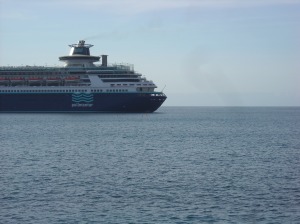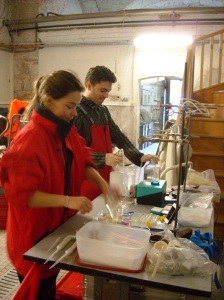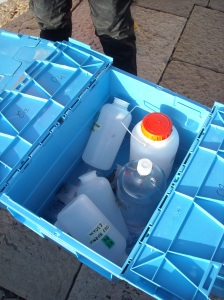Dear Reader,
The blog has change host, the new address is now: http://medseavillefranche2013.obs-vlfr.fr/
Thanks for your interest,
Best regards.

Dear Reader,
The blog has change host, the new address is now: http://medseavillefranche2013.obs-vlfr.fr/
Thanks for your interest,
Best regards.
It’s been 10 Days since we announced the experiment was stopped few days before what we scheduled. Since this date, all the material have been bring back in land (the last buoys just arrived this afternoon). And it was just on time because the passengers ferry season has started. And when one of this big floating building enter the Bay, this one seems to be very tiny. We experienced at the beginning of the experiment how it is to work on mesocosms with a ferry next to us and didn’t really liked it…

The remaining buoys near one of the first passenger ferry of the season!
So, in 10 Days the local team did a huge work of destruction and carrying the material to their place. Like for the instalation it has been a bit challenging as our marine station is in very old buildings with stairs, doors and no lift… Here are some of the pictures of the destruction activity:

Then we have to remove all the rings from the plastic cover…all the material which can be re-used has to be taken!

After that the very dirty, smelly, sticky activity can start: remove the plastic of the bags of the pipe structure….In total 3 very unlpeasant days…
Dear readers,
Forced by the meteorological conditions that we have faced in the last days, we have to stop the experiment. On March 6th, the wind blew at more than 110 km/h, creating lots of waves in the bay. We have continued the experiment for few more days, but we realized something went wrong when looking at the CTD profiles. Although our mesocosms are well covered with a Teflon roof in order to prevent rain to enter inside the bags, we saw that salinity dropped significantly at surface in all mesocosms after March 7th. Divers from LOV inspected the bags and our fear was justified. All of the bags with no exceptions presented many scratches in the first meters. We have considered (and actually tried) lifting up the bags in order to put these scratches above the sea level, but we had to give up as for some of them the bag was deteriorated way too deep below the sea surface. That is very unfortunate, Villefranche bay is a safe sheltered place for more than 350 days a year, our experiment coincided with very windy conditions from the East, allowing waves and swells to enter inside the bay. All is not dark of course, this could have happened at the start of the experiment and all in all I think we have been lucky collecting more than 2 weeks of data.
Now it’s time for us to start removing the mesocosms from the bay, our partners will move back to their home countries in the coming days and will start analysing the precious samples. We’ll come back for more news at a later stage!
Keep posted
F
Oxygen represents about 21% of the air and it naturally dissolves into the ocean through gas exchanges between the water and the atmosphere. The concentration of dissolved oxygen in seawater is an important parameter used by physicist, chemist and biologist in oceanography. It enables to study the water masses, the redox potential of a water column or the biological processes that consume/release oxygen for example.
The Winkler method is a rapid and accurate way to measure dissolved oxygen in water samples. It owes its name to its inventor Lajos Winkler, a Hungarian chemist, who made it up in 1888 while he was still a doctorate student. The method was then improved in 1965 by Carpenter.

Filling 225 BOD right after the 5am sampling …

Winkler equipment
The objective is to estimate the production and the respiration of the planktonic community inside the mesocosms. As we study two oxygen-related biological processes, we are going to estimate them measuring oxygen differences after light or dark incubations.
The sampling of the mesocosms has to be done before the sunrise (5 am ready to leave the harbour)! Back on land, the BOD are filled with the seawater collected and a part of the bottles is directly fixed (means that the dissolved oxygen is trapped) adding reagents 1 & 2. The amount of oxygen measured is the initial concentration (T0), the initial state of the system. The rest of the BOD are incubated in the dark or in the light for 24H. After that time period, these bottles are also fixed and the concentration of oxygen is measured.
The oxygen difference between T0 and T24 light incubations represents the production while the difference between T0 and T24 dark incubations represents the respiration of the community.

From left to right: BOD filled with only seawater; the precipitate resulting from the addition of reagent 1 & 2; before the analysis, when reagent 3 has been added.
The addition of reagents 1 & 2 in the sample (the fixation) traps the oxygen: in the basic environment created by the addition of NaOH, manganic hydroxides are formed resulting in a brown precipitate. The dissolved oxygen oxidize the manganese and convert the Mn(II) hydroxides into Mn(III) hydroxides, so the amount of Mn(III) actually corresponds to the amount of oxygen. This first reaction needs at least 5h to take place. After that, the sample is acidified just before the analysis. In an acid environment, the manganic hydroxides dissolve. The Mn(III) released oxidise the iodide ions (I-) previously added (reagent 2) to iodine (I2). Finally, the iodine is titrated by the thiosulfate (iodine is reduced and thiosulfate oxidised), the orange colour of the sample disappear slowly during the titration. At the end, the equivalent volume of thiosulfate is determined by the titrator and as we know that four moles of thiosulfate react with one mole of oxygen, the amount of oxygen in the sample can be determined. Considering the exact volume of the bottle (the BOD have all been previously calibrated) the oxygen concentration can be computed in µmol/L.
Welcome to the cave (or wet lab), home to a special group of people known as team SFES (sample, filter, eat & sleep), complete with sterile gloves, wellington boots (rubber boots/sailing boots for the internationals), many bottles of seawater and filtering rigs.
The day starts off with a refreshing early morning at 5am to…. you’ve guessed it, sample the mesocosms. Next on the agenda is filtering for ~ 8 hours, this sometimes has a bit of a cave disco vibe to it with flashing head torches, questionable music taste and wonderfully poor singing.
As the sun starts to dip we emerge from the cave in search of food and a nice pillow to rest our heads. After a few weeks of eating out in Villefranche, we could probably write a paper on how to confuse the waiter by ordering in 4 languages.
Time for bed and alarm set for 04:15am.
The song says ‘All you need is love‘ in mesocosms experiment we’ll say ‘All you need is GLOVES’!! When we are sampling some of the parameters need to be protected from us. That maybe sound strange but we are a source of contamination because of our skin and hairs. To measure some of the nutrients (ammonium, nitrate, nitrite, phosphate, …) as well as metals. So, the best way we could sample would be cover from head to toe and change every day… but not very doable as we have to wear sailing clothes!
To minimize the contamination, we have few things to do. First of all is to wear gloves but also avoid to touch our hair or skin (not very easy when we want to itch or to blow its nose!). The boxes have to be rinsed every day and even on the cubis, the back of the box with the sampler has to be rinsed into seawater before placing the sampler on it…. All a clean process taught by Cécile and Justine the two “clean room’s” scientists.
When Cécile and Justine aren’t dressed with nice sailing clothes they are with white labcoat, ‘charlotte’ to avoid contamination with hairs and overshoes…all this to avoid contamination. Justine, is measuring nano-nutrients which are the elements used by phytoplankton to growth but very easy to contaminate. She already explained her part during the previous experiment.
NB: pictures for this post are coming soon…
In our experiment, there is a type of people who work by night: it’s the 5am sampling team. We explained you why we have to do it in a previous post.
Here are some of the pictures we took while it wasn’t raining during a dark beautiful night! and there is more pictures in the Gallery.
But the best it’s always the sunrise. A little sunlight’s moment before we hole up in our laboratories…

Justine, Bruno and Angela are finishing to prepare the boxes for the sampling and the samplers are ready to use!
Here is our material list when we have to sample. We already talked about the ‘cubis’ which are 9m2 platforms with 80cm freeboard from which we do all our sampling. Except microlayer and atmosphere exchange, the samples are taken along the 12m depth of the water column using a ‘sampler’. Actually it’s like a big syringe with a plunger moving as long as we go down to the mesocosm. Each run is 5 liters of water and most of the time we have to do 3 runs (‘cast’ in Mesocosms Vocabulary). Once the ‘sampler’ is back at the surface, one person of the team use the hook to bring the sampler on the side of the mesocosm and with a nice mouvement the sampler as to be on a box without touching the cubi (to avoid contamination). Not always easy because relatively heavy and even harder when there is swell or wind!!

Content of one box for 8.30am sampling: 3 bottles for organic matter; 1 for carbon isotope; 1 for nutrients; 1 for pigments and 3 small flasks for carbonate chemistry.
Once the sampler is secured, we can start to pour the water from the ‘sampler’ to the multiple different sub-bottles. Some of them have to be rinsed other not; some need to be filled without bubbles (create air-water exchange which bias the analysis) … took us few sampling to find the best way to fulfill each of the parameters! For each mesocosm we have a box containing all the bottles. So, 1 box for the ‘sampler’; 3 boxes for the bottles to fill (4 for the team who is doing the outside sampling) and one kook: doesn’t leave lot of space for the 2 people on the cubis!
The bad weather conditions continue and forces the different teams to stay on the labs or their rooms. Specially the wind has not been on our side. Yesterday the sampling that was suppose to take place at 8:30 was delayed until 12:30 and today`s is completely cancelled. In the morning we could hear the wind blowing strong and making things fly away in Nice. Up to 26 kts are expected, and this is sufficient to create waves that are difficult to handle during sampling.

Map of the wind forecast from: http://en.windfinder.com/forecast/nice
Security of all participants comes first, and nobody wants to fall in the waters of 12 – 13°C
So far, the panorama for tomorrow looks very different and we expect to have the normal early morning and 8:30 samplings.
Most of the people when studying ocean are sampling into the water column. However before entering into the oceans a skin have to be crossed. The few micrometers separating the water column and atmosphere is called microlayer and many interesting process occur. Alina explain us how to sample the microlayer and analyze trace metals (metals elements with very low concentration).
I have devised a new sampling method to get microlayer samples for trace metals. The sampler is a quartz tube that is dipped vertically into the water; then slowly raised out of the water vertically. The water that drips off the tube is, in theory, the microlayer and is collected into a funnel that is connected to a receiving bottle. Normally sampling the microlayer is done on calm days with little to no wind and waves.On Friday March 1 however, we had a treat and it was windy! It is good to get days where we think there is no microlayer (or it is well mixed) to compare to the calm days. The surface team had a fun roaster coaster ride on the cubi and earned the title of only team to sample that day!
The real fun begins for me after I leave this campaign…well, not really, but the bulk of sample analysis for me will be done in the labs on Florida State University’s campus and also at the National High Magnetic Field Lab, located down the street from campus. So for those of you that are jealous of my afternoons off, don’t be because once I go home I will have 12 hour days for a few weeks. Ever wonder how to analyze trace elements in nMolar concentration in seawater? Well, you have come to the right person! I have spent the better part (or worse depending on my mood that day) of the last 3 years learning techniques to determine the concentrations of trace elements in the dissolved and particulate phases of the water column.
The dissolved phase, for me, is what passes through a 0.4 μm pore sized filter. I look at 10 elements, iron (Fe) being the most important as it is a major minor nutrient for marine critters. The concentrations typically found in the dissolved phase are nMolar to pMolar in oligotrophic environments for Fe and the other elements I study (I have them all listed on my information page). My research group uses an inductively-coupled plasma-mass spectrometer (ICP-MS) to determine the concentrations. Now, anyone who has worked around an ICP-MS knows that sending straight seawater through it is a very bad idea. All the salts in seawater cause many issues and your data would not be reliable, if you manage to get any before your front end clogs up. In order to get around the problem, my research group uses extraction columns which remove the metals from the seawater (Milne et al., 2010). The column has resin inside that acts as a binding site for the metals. The metals will adhere to the resin while the rest of the salts will pass through into waste when you get the pH of the sample right (something that takes a lot of practice). Nitric acid (1.0 Molar) is then sent over the column that elutes the metals and sends them to a small collection vial. The extraction process also concentrates the metals about 10 times, which makes it easier to analyze them on the ICP-MS. This process (I left out a couple of steps for simplicity sake) takes 9 minutes per sample. 40 samples per day are about my limit as I must sit with the system the entire time. The whole process is done in a Class-100 clean lab and I wear my little pastry chef outfit (hairnet, lab coat, gloves, clean lab shoes) to keep things as clean as possible. The extracted samples are then ready to analyze on the ICP-MS. Sounds like fun, right?
The particulate phase is a quicker and an easier process. I save all my filters that my samples went through. The filters are simply digested in order to get the total metal concentrations on the particles. The digestion potion is a lovely combination of concentrated nitric, hydrochloric, and hydrofluoric acids (yum!) that dissolves the particle minerals. They are then dried down, re-suspended in 0.34 Molar (2%) HNO3 and analyzed on the ICP-MS. So, if I don’t die from digesting ~200 filters, I will be able to share the metal particulate concentrations.
Lots to do when I get home and not a lot of time to do it as I’m working on writing my Master’s thesis for an October 2013 defense and a publication on my microlayer sampler! Good thing we didn’t sample today or tomorrow, maybe I can be productive?